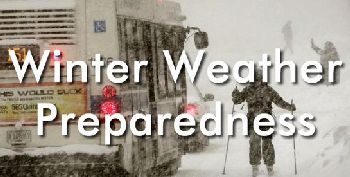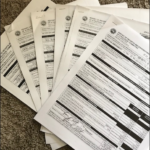 November 10th – 16th has been designated as Winter Weather Preparedness Week in Indiana. Although winter does not officially arrive until December 21st, next week will provide us with a preview of coming attractions.
November 10th – 16th has been designated as Winter Weather Preparedness Week in Indiana. Although winter does not officially arrive until December 21st, next week will provide us with a preview of coming attractions.
Being prepared and having a plan will help keep you safe and minimize the impact caused by winter weather. Here are a few recommendations on how you can be ready for what Mother Nature has in store for us this winter:
Stay Informed:
The National Weather Service outlooks and watches can provide you a heads up on storm potential days in advance. Weather warnings and advisories indicate weather conditions that are likely to cause you problems, have already begun, or will begin soon. It is important to know the terms used by weather forecasters so that you clearly understand the risk to you and your family.
- Winter Weather Advisory – Winter weather conditions are expected to cause significant inconveniences and may be hazardous, especially to motorists.
- Winter Storm Watch – Be alert, a storm is possible.
- Winter storm warning – Take action, the storm is occurring or will soon occur in the area
- Blizzard warning – Snow combined with strong winds can produce near zero visibility, deep drifts, and life-threatening wind chill, seek shelter immediately.
Winter Weather Safety Tips:
- Most winter weather related deaths are a result of auto accidents on slippery roads, so drive with more caution when roads are bad.
- Know before you go. Check on local travel restrictions for each county at: (www.in.gov/dhs/traveladvisory/). You can also check highway conditions from INDOT at (https://indot.carsprogram.org)
- Give yourself plenty of extra travel time to reach your destination. S-L-O-W down and adjust your following distance for the road conditions. Bridges and overpasses become slick and icy before roads do.
- Clean snow from your windshield, head and tail-lights.
- Make sure your vehicle tires are in good shape and have adequate tread for traction.
- Keep your gas tank at least half full.
- Put together an emergency kit to carry in your vehicle. Your kit should include:
o Mobile phone charger
o Extra clothing, blankets or a sleeping bag
o Flashlight and extra batteries
o Jumper cables
o Tow strap
o Small tool kit
o Emergency flares
o Shovel
o Sand or cat litter for traction
o Windshield scraper and brush
o High-calorie, non-perishable food
o First-aid kit
o Knife
o Toilet paper
o Waterproof matches or lighter
o Small can to melt snow for drinking water
- Other winter weather related injuries and deaths can result from slips and falls, over exertion, and exposure to cold. Clear sidewalks and driveways of snow and ice, take frequent breaks while shoveling, and minimize skin exposure by always dressing appropriately, or limiting outdoor activities due to the frigid temperatures.
- Poorly maintained heating systems also lead to deaths in fires or by carbon monoxide poisoning. Have your furnace and chimney checked by professionals for proper operation and venting. Install smoke detectors and carbon monoxide detectors in your home, or inspect the ones you have to make sure they are functioning properly. Make sure that alternative heating sources are kept clear of clutter and that fuel is stored far away from ignition sources.
- Finally, use common sense and caution. Listen to NOAA Weather Radio or commercial radio or television for the latest information regarding weather conditions. Take action when the National Weather Service issues a watch, warning or advisory.
For additional information regarding winter weather preparedness, you can contact the Marshall County Emergency Management Agency at 936-3740. Sign up to receive alerts at NIXLE.com or follow us on Facebook and Twitter.
Remember: Emergency Preparedness Is Everyone’s Responsibility













